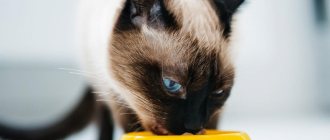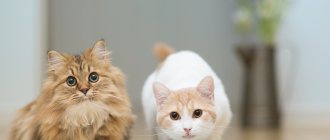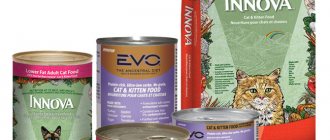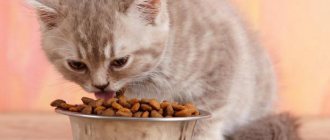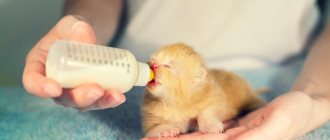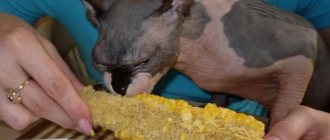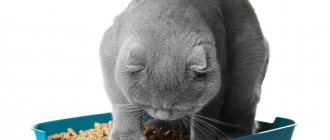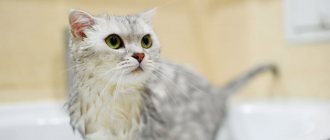Domestic cats are very finicky creatures, but the creators of dry food managed to please them. Most purrs, having tried dry granules, refuse to return to natural food. This is very convenient for owners, but the question becomes urgent: how to properly feed a cat with dry food?
How to properly feed your cat dry food
Is it possible to feed dry food and natural food at the same time?
A varied diet is important for cats ; this does not mean that a small predator needs delicacies. Under natural conditions, representatives of the cat family eat certain foods throughout their lives. The main thing is that food serves as a source of nutrients in the right proportion.
A pet cannot choose its own food ; the owner must decide what type of food is suitable for the animal. Dry pads are preferable to food from a person's table. But natural products (meat, milk, fish, vegetables), prepared taking into account the cat’s needs, will bring tangible benefits to the body.
Doctors do not recommend feeding industrial food and natural food at the same time. A mixed type of feeding will lead to imbalance, indigestion, gastritis, and colitis. The animal's metabolism will be disrupted.
What is the best food for a cat?
Complete food in the form of dry food is designed specifically to ensure that the cat receives all the necessary substances, vitamins and microelements. So if you feed the animal something else, you can create an imbalance in the body. It is often difficult for owners to calculate how much protein, fat, carbohydrates and other substances a cat needs, and if you feed the animal thoughtlessly, you can cause a deficiency or excessive content of any substance in the cat’s body. That is why you should not experiment with mixed food, but give your beloved pet high-quality and balanced dry food, which will undoubtedly be beneficial and your cat will like it.
Is it possible to feed a kitten this way?
In some cases, an adult animal can be given two types of food, dividing the intake by time. It is strictly forbidden to feed a kitten with natural food if the baby is accustomed to specialized canned food from birth.
Be sure to read: 4 methods on how to switch a cat from dry food to homemade food A gradual transition to natural food is possible from the age of two months.
Benefits of dry food
The most important advantage of “drying” for owners is convenience. Domestic cats are very capricious when choosing food, often refusing natural products and tormenting their owners with persistent, hungry meows. There are no such problems with dry food. Pets willingly crunch on the usual granules without being picky.
Dry food does not need to be prepared
In addition to convenience, proper dry food also has the following advantages:
- contains all the necessary substances in balanced quantities;
- long shelf life;
- An animal fed dry often looks better than one fed naturally, due to the presence of vitamins, minerals and amino acids.
Table 2. Dry food and natural food (advantages and disadvantages).
| Type of feed | Shelf life | Need for vitamins | Water requirement | Financial expenses |
| Dry | 1 year | No | Big | Depends on class |
| Straight | 1-2 hours after preparation | Yes | Small | Significant, considering the number of food refusals |
An undoubted advantage of dry food is the indifference of animals to natural food. Owners living in the country or in their own home should not be afraid that the cat will eat a poisoned mouse or a sick bird. The pet can bring prey home, but will go to its bowl to eat.
How many times to feed...
If a cat is accustomed to a routine, she will quickly get used to the fact that food appears in her bowl at exactly the scheduled time. In this case, one of the most unpleasant problems - begging near the table - will disappear. How many times to feed your cat dry food depends on the age of the pet and its condition.
Table - Number of pet feedings
| Pet age | Number of receptions, times |
| Kittens up to 6 months | 3 |
| Pets from 6 to 8-9 months (before sterilization or castration) | 2-3 |
| Neutered cats | 1-2 |
| Neutered cats | 2 |
| Pregnant cats | 3 |
| Nursing cats | 3-4 |
| Elderly pets | 1 |
What is better - dry food or natural
This topic can be debated for a long time, but the decisive factors when deciding how to feed a cat are:
- personal preferences of the pet;
- his state of health;
- owner's lifestyle.
Responsible choice
If a cat resolutely refuses “drying” in favor of natural meat or fish, then you should not insist on eating crunches.
Most foods that people love to eat are dangerous for cats. They cause indigestion, weakness, urolithiasis and other troubles. Your pet should have a balanced diet. Find out what you should not feed cats and for what reasons in our separate article.
But still, the vast majority of cats make their choice in favor of dry food, which makes life much easier for their owners.
Regardless of what you choose for your pet, you need to follow the basic rule - do not combine incompatible things, that is, drying and natural.
When do you need to change the type or diet of feeding?
Restrictions:
- It is prohibited to introduce dry food and homemade food into your pet’s diet.
- You cannot feed raw and boiled foods at the same time.
It should be noted that premium industrial food contains a sufficient amount of useful substances: necessary for the full development of a small predator. Adding natural food to the diet can cause disruption in the animal’s body.
The combined use of two types of products is allowed only when changing the diet.
A change in diet is necessary if:
- the animal ages, matures;
- the pet has been diagnosed with a chronic disease;
- castration or sterilization surgery awaits;
- food allergy detected.
The change in diet should be gradual, new food should be introduced in small portions, gradually completely removing the previous food from the diet. The cat is transferred to a new diet within 20-25 days.
It is forbidden to treat your cat with pieces “from the table”. Food is given out in several stages. One stage is natural food, the second stage is dry pads, the share of new food increases every day. Food bowls should be removed as soon as the animal has eaten.
Is dry food harmful?
Dry food is not acceptable for humans, and constantly eating crackers and chemical freeze-dried food is very harmful. However, this should not be confused with cat food.
Rusks, for example, do not contain anything useful except empty carbohydrates, and chemical additives and spices will not bring anything good to health.
Dry cat food can be compared to food for astronauts, which contains all the necessary substances and vitamins in concentrated form.
It is worth noting that good dry cat food contains only natural substances: meat, fish, grains, etc.
Also, many owners claim that dry food causes kidney stones in cats. In fact, urolithiasis can develop for a variety of reasons:
- Transmitted genetically.
- The appearance of inflammatory processes and genitourinary infections.
- Insufficient water intake.
- Obesity.
- Poor quality food and excessive overfeeding.
Feed, but know when to stop
Dry food is a diet made up of many different ingredients, balanced together to ensure your pet gets all the nutrients it needs. High-quality dry food for cats should consist primarily of ingredients of animal origin, because these pets continue to be obligate carnivores, adapted to eat only meat. Foods consisting of 75–85% meat ingredients are better digestible and satiate cats, so their feeding standards are lower than those of products containing a lot of grain and vegetable protein.
The daily consumption rate of dry food is indicated on its packaging and depends on the weight and age of the animal. Determining it is quite simple, just carefully study the table, but if you have any difficulties, read our article “How much dry food does a cat need per day,” which contains detailed instructions.
It is not recommended to exceed the recommended amount of dry food, but each animal has its own individual needs, so if it seems to you that the pet is losing weight or, conversely, gaining weight, you can slightly, by no more than 10%, adjust it, carefully monitoring how it feels. and the physical form of the cat.
Is it possible to feed dry food and meat at the same time?
A meat diet is most suitable for cats, and dry mixtures do not always contain the required amount of meat ingredients. Many owners of furry animals try to supplement their pets' diet with meat, fearing that the animal is not getting enough nutrients.
Premium industrial mixtures are perfectly balanced and contain all the nutrients necessary for a cat’s body. It is allowed to allow your pet some meat (boiled, frozen) as a treat, but introducing meat products into daily feeding is irrational.
The share of treats should be no more than ten percent of the daily portion. It is recommended to serve meat a few hours after eating.
Be sure to read:
Poisonous plants for cats: a list of dangerous indoor plants, in bouquets, from the dacha, what to do if you eat them
It is forbidden to mix dry mixture and raw meat. Heat-treated mixtures are digested faster than raw meat, resulting in vomiting, discomfort, and digestive problems in the cat.
How to calculate the daily feeding rate for cats and cats?
To understand how to feed your cat dry food, you need to find out if she is overweight. This is determined visually and by touch. If the ribs and chest are visible, then the animal’s weight is in short supply. If you can feel the fat layer and you can’t see the ribs or pelvic bones, then the cat is overweight. Based on weight and age, you can determine the daily dose of food. The feed rate is shown in the table.
| Weight, kg | Daily dose, g | Age (months) | Daily dose, g |
| 3 | 45 | 1-2 | 30-50 |
| 4 | 55 | 2-4 | 40-65 |
| 5 | 65 | 4-6 | 55-70 |
| 6 or more | 12 g per 1 kg of weight | 6-12 | 60-80 |
Nutritional features of kittens
Kitten food
The body of a small kitten and an adult are different, therefore, the nutrition of babies is different. Food for one-year-old cats is not suitable for monthly cats. Their body is still developing, so it requires large quantities of nutrients. The energy value of cat food is lower than that required for infant nutrition. In addition, such food is hard for the kitten’s fragile teeth.
It is recommended to feed kittens 3-4 times a day in small portions and mostly natural food. Economy class food does not contain enough elements that babies need. They can lead to digestive disorders. For babies, it is worth choosing holistic foods that will provide the body with the necessary nutrients.
For a month after birth, kittens feed on their mother's milk; the transition to a dehydrated diet should be consistent. First, the babies are treated to dry food as a treat, several pieces a day. The transition to this diet lasts 4-5 weeks, and after that the animal can begin to eat this way every day.
Nutrition for an adult cat
Nutrition for an adult cat
The frequency of feeding an adult cat is determined in accordance with the characteristics of the body, level of physical activity, weight and breed. The average rate of meals is 1-2 times a day. Some breeds, such as Maine Coon, British and Scottish, are large in size, so the figure can be increased.
Cats with a high level of activity expend a lot of energy and therefore need to restore their body. They need to be fed more often.
Nutrition should be balanced and rational. The necessary macro- and micronutrients and minerals must be supplied with food. It is advisable to buy premium, super-premium or holistic food. These foods are rich in nutrients, contain high-quality ingredients, and also contain meat in the right proportions for the cat.
It is important to understand that dry food is a dehydrated food, so a bowl of water should always be in sight to keep your cat hydrated.
Rules for feeding cats after castration and sterilization
Nutrition for a sterilized cat
After castration and sterilization, the animals' appetite increases. Cats begin to rapidly gain weight, which can lead to obesity.
The first meal after surgery should take place no earlier than 8-10 hours later, because food can cause vomiting. You need to make sure that there is always clean water in the bowl. This will help avoid dehydration. For the first time after the procedure, pets are fed special food for sterilized animals. Food is served in crushed form and in small portions.
Sterilized animals are prone to weight gain; it is advisable to think through their diet in advance to avoid obesity and eating disorders. Food should be natural and dietary. It is worth choosing food with a good composition. It is better to avoid buying economy class products.
Feed the animals in small portions; do not leave a bowl of food. There is no need to worry, the cat can easily withstand several hours without food.
Once a week you can have a fasting day.
The condition of the animal depends on the approach of its owner. Prepare your diet in advance and don’t skimp on quality food.
Feeding standards for pregnant and lactating cats
Nutrition for a pregnant cat
Bearing children takes a lot of energy from cats. From the third week of pregnancy, the number of meals is increased to three. Mothers need vitamins and minerals in large quantities. They increase the fat content in the diet, which has a beneficial effect on the gestation of kittens.
From the 7th week of pregnancy, the number of doses is increased to 4-5.
After pregnancy, the cat needs recovery. To prevent health problems, the animal is fed 5-6 times a day with high-quality food. It is advisable to serve food in liquid form so that milk is released more abundantly.
How to feed older cats?
Feeding an older cat
As cats age, they begin to move less. They play and run around a little. With an incorrect and unbalanced diet, obesity can begin.
It is important to take into account the fact that metabolism slows down and the digestive tract does not break down food as efficiently.
For older individuals, split meals are suitable. It is better to feed more often, but little by little. Your cat may have difficulty digesting, so it is recommended to switch from dry food to wet food.
To prevent your pet from experiencing constipation and other digestive problems, provide enough fiber and reduce phosphorus.
Benefit or harm?
So, there is no need to doubt: it is possible and even necessary to feed your cat only dry food. But you need to approach the choice of brand extremely responsibly. After all, poor quality food will negatively affect the health of the animal, and the consequences may appear months and even years later.
Cheap food contains components that are harmful to cats, such as:
- flavorings;
- dyes;
- odor and taste enhancers;
- preservatives.
Products from unscrupulous producers also contain excess salt, sugar, spices, starch, and instead of real meat, offal and meat waste. This mainly applies to economy-class feed, but it also occurs among brands that position themselves as premium (read more about the classification of feed below).
Professional food, subject to proper selection, on the contrary, will become the key to health and longevity for your pet. They contain the following useful components:
- natural meat of a certain variety (beef, chicken, turkey, rabbit, etc.);
- complex of vitamins and minerals;
- amino acids;
- probiotics.
Moreover, all these components of good food are in an optimal ratio for the cat’s body.
Professional “drying” is noticeably more expensive than advertised budget brands, but in fact its use saves money for the attentive owner. It’s hard to disagree with this if you think about the costs for medicines and veterinarians that feeding your pet with low-quality, cheap food will entail.
In addition, due to the balance and higher energy value of a good product, a cat will have enough for a longer period.
The cat does not eat dry food: why, what to do?
The cat doesn't eat food
Why might a cat not eat dry food? The reasons are as follows:
- She's not hungry. If you feed your pet something tasty during the day, the cat may refuse the food that is put in the bowl. In order for him to start eating the food that is given to him, you need to not succumb to his tricks.
- The food is not suitable for the pet. If you buy cheap, economy-class food that lacks nutrients, then he may refuse to eat.
- Loss of appetite can be a symptom of various diseases. If, in addition, you notice apathy, fatigue and other signs of illness in your pet, visit a veterinarian.
- The expiration date has expired. It is better to check the expiration date of the food and if the food is spoiled, buy fresh food.
It is important to be attentive to the health of your animal and monitor its well-being.
When is industrial food better than natural food?
Your pet should be switched to dry pads if:
- The owner does not have the opportunity to devote much time to the animal. The ideal choice in this case is an automatic feeder. Wet canned food, cereals, and meat spoil if they lie in a bowl for a long time. The pads always stay fresh.
- The animal was castrated and sterilized. Feeding your pet after surgery should be completely changed. The body ceases to need large amounts of carbohydrates, but the volume of food should be kept at the same level. The solution is specialized dry pads for sterilized animals.
- with liver and kidney pathology, urolithiasis, diabetes, and allergic reactions. In this case, the doctor recommends specialized food.
How to choose food
To avoid making a mistake with your choice, you should follow a few simple recommendations:
- Consider the characteristics of your pet.
If you are the owner of an elderly, neutered cat, or, for example, a pregnant cat, you need to select the appropriate diet. - Study the composition.
This is all clear - before purchasing, read the information about the manufacturer and the breakdown of components. The abundance of artificial additives and the lack of specificity in the list of ingredients (for example, “meat and offal” - it is not clear what exactly the manufacturer means) should alert you. - Read the reviews.
It is worth noting that not all of them are true, but you can get a general impression. You can also talk to your veterinarian about this or that food. - Watch your pet.
After switching to a new food, carefully monitor the cat's condition. If he has no allergies, digestive system disorders or strange behavior, everything is fine and the food is most likely suitable.
It is also worth familiarizing yourself with the brief classification of feed according to their quality:
- Economy class.
The most budget option for a cat menu. Instead of meat, manufacturers use offal, grains, and plant components that are poorly absorbed by the cat’s body. It is strictly not recommended for long-term nutrition. - Premium class.
These are feeds of average quality, which contain a certain percentage of meat, as well as vitamins and minerals, but at the same time there are also artificial additives. They are relatively inexpensive and available in most stores. - Super premium class.
Perhaps the most optimal option: the relatively high price is justified by high-quality raw materials and the absence of artificial components. They contain a large percentage of natural meat and all the necessary vitamin supplements. - Holistic.
These are really expensive foods that are positioned as the best of the best.
Myths about commercial dry cat food
Any product, be it cat food or cottage cheese from the store, is surrounded by myths and unfounded conclusions. The factory-made diets discussed in breeder and veterinarian circles have also been given some false properties that pet lovers need to be aware of.
Myth 1: drying causes urolithiasis
The mistake is that pelleted feed is considered the cause of diseases. This is not true; the real problem lies in the lack of fluid. If a cat drinks little and eats only dry food, illness cannot be avoided. To eliminate the danger, doctors recommend giving pets water in unlimited quantities and keeping it clean and fresh. It is important to know that some types of diets are preventive and are used in the treatment of urolithiasis.
Myth 2: Industrial feed causes allergies
This cannot be true. Two people sitting at the same table and eating the same food may react differently to it. One will be upset, and the other will not notice anything. It's the same with animals. Each organism is unique, and if you feed your cat natural food, the risk of an allergic reaction is just as great as when feeding dry diets. Knowing the characteristics of your pet, carefully study the composition of the product before purchasing.
It is better to consult a doctor. Possible animal allergens include starch, soy, corn, some grains and grasses. Most of the listed products are used in economy and premium food.
Conclusion: do not skimp on food, including dry food, and carefully check the composition. Some good dry diets include Orijen, Acana, GO!, AATU, Summit Holistic, Applaws. Please note that all this food is holistic or super premium. They cost from 350 rubles. per kg for the cheapest Summit Holistic and up to 800-1000 rubles. for Orijen, Acana.
Myth 3: waste is used in the production of feed
In fact, it is not known what types of meat are used to prepare cat food. Perhaps these are dead animals or food industry waste. However, choosing products from well-known brands approved by veterinary associations eliminates the risk factor. Super premium and holistic food cannot contain dangerous ingredients, they are tested in laboratories and even possibly harmful components are listed on the packaging.
Which is better: natural or prepared food?
It is difficult to answer the question unambiguously. Premium class industrial mixtures contain all the nutrients an animal needs. The mixtures do not require a long time to prepare, always remain fresh, free the owner from constant care, but are expensive.
Eating natural foods has many benefits. The owner is confident in the contents of the bowl, knows exactly what ingredients were prepared, and can adjust the diet depending on the cat’s taste preferences.
Disadvantages - food spoils quickly, a lot of time is spent on preparation, the cost of quality products is high.
Norm of dry food per day
When feeding dry food, it is important to adhere to the correct dosage. It depends on the weight and activity of the animal and is always indicated on the pack of food. For sedentary overweight pets, take the minimum amount of food, for active ones - the maximum. The average norms can be changed in accordance with the individual needs of the animal, as well as in the process of monitoring weight gain or loss on this food.
The recommended dosage of this product is always indicated on food packaging depending on the weight of the animal.
To avoid regularly weighing food, it will be convenient to have a special measuring cup for feeding. It is sold in stores, but you can make it yourself from an ordinary plastic cup, marking the required content level on it.
The daily dose of food can be given once or divided into two doses: morning and evening. It is important not to overfeed a cat, since in nature a predator eats as much meat as it gets, making reserves in the body in case of hunger. But at home, malnutrition is not expected, and the amount of food should be moderate. The cat itself cannot determine the optimal dose of food for itself and will overeat without control from the owner.
Good food is absorbed by the animal’s body by 70–80% and the volume of excretion is no more than a quarter of what was eaten. The less food is digested, the more the cat defecates.
It is very important that the cat drinks a lot of clean and high-quality water - approximately 4 times the weight of the food eaten. If a cat drinks from the tap, then he should still have a bowl of fresh water, because the owners cannot always open the tap at his request. If it turns out that the pet drinks little, then veterinarians recommend supplementing the animal with a syringe to prevent urinary tract pathologies. But usually, if there is free access to water, the cat itself consumes it in the amount required by the body.
When feeding ready-made food, an important condition for good cat health is free access to drinking water.
Bottom line
There is no clear opinion in favor of one type of nutrition or another. Some people prefer to feed the animal the old fashioned way, from the table. Some people “work magic” in the kitchen and create a completely balanced meal for their pets on their own. But the majority still purchase industrial food, since it is completely tailored to the needs of the tailed beauty. When choosing the type of feeding, it is important to consider your capabilities and the desires of your pet. If you want to cook Murka separately, then fine. If you don’t have the time and energy to create masterpieces of cat cooking, then it is better to purchase ready-made food, but always of good quality.
Pros and cons of cooking your own food
The main disadvantages of a natural diet:
- risk of helminthiasis;
- difficulty in achieving the right balance;
- time spent on preparing food;
- the need to comply with storage rules and expiration dates of the finished product.
To feed a pet on its own, the owner will need to make an effort to fill the gaps in knowledge of cat physiology. Currently, this is not difficult to do, the necessary literature is quite accessible, and attempts to “reinvent the wheel” in this case can be dangerous for the health of the animal.
You will have to prepare food for your pet yourself
The basic rules for feeding cats are not as complicated as they might seem at first glance. In addition, such nutrition has a number of significant advantages:
- the pet eats only natural products, without preservatives, flavor enhancers and synthetic dyes;
- fresh meat is the most natural component for the digestive tract of a predator;
- When preparing, it is possible to take into account the taste preferences of each baby.
It is extremely important to feed your cat regularly. These animals can fast for no longer than two days without harm to their health. A longer absence of food can provoke irreversible changes in the pet's liver.
How to accustom your pet to dry food
Switching a cat to dry food at any age is a very responsible step. You need to be aware that there will most likely be no turning back. It is very difficult to transfer a cat from drying to natural drying; it requires patience and qualified assistance from a veterinarian.
Tasty and convenient!
Accustoming an animal to dry food with the right choice goes quickly, within 1-2 weeks. Kittens get used to dry food especially quickly.
Training kittens
Premium dry food, as a rule, begins to be given no earlier than 3 months, purchasing special food for kittens.
At an earlier age (from 4 weeks), only holistic treatments are strongly recommended. For example, Orijen or Felidae. They form healthy intestinal microflora and prevent the emergence of unhealthy eating habits. Holistics for kittens can be combined with a breast milk substitute, and after reaching 2 months - with lactose-free milk half diluted with water.
Felidae Orijen
After 3 months, the pet can be switched to a more budget food, but not lower than the premium class.
Important! Premium dry food cannot be combined with milk.
Video - how to properly introduce dry food into a kitten’s diet
Transfer to “drying” adult cats
After choosing a brand and brand of dry food, the animal begins to accustom it to it following the following scheme:
- morning - natural, familiar food. The bowl is removed, leaving only fresh water;
- evening - only dry food and water. The bowl can be left overnight;
- The next portion of food should be offered no earlier than 8-10 hours later.
Diet is the most important component of your pet's health. At the same time, it is rare that anyone can afford to sit near a cat 24 hours a day and serve it food at the right time in the right quantity. An automatic cat feeder, assembled with your own hands and presented to your favorite creature, will come to the aid of such pedantic owners of representatives of the cat family. You can read more about how to make an automatic feeder in our separate article.
Automatic feeder
After 2-3 days, most cats begin to ignore natural food in favor of “drying”. For 2-3 weeks, the owner needs to be vigilant, monitoring the animal for:
- signs of allergy (rash, itching);
According to statistics, every fifth cat owner goes to the vet specifically with manifestations of allergies. About 10% of all types of allergic reactions occur due to food. It is the feed (nutritional) allergy that becomes the culprit of itching and scratching in 57% of cases. Find out about food allergies in cats in our special article.
- digestive disorders (constipation, diarrhea, vomiting);
- compliance with the drinking regime (at least 20 ml of water per kg of weight). If the pet does not drink on its own, give it water from a syringe.
When the first signs of an allergy or gastrointestinal disorder appear, the transfer to dry food is stopped, returning the animal to natural food. The next transfer attempt can be repeated only after a month with a different brand of dry food.
If the cat begins to refuse dry food
A pet can go on a hunger strike for external or internal (physiological) reasons. The first include:
- stress. Guests, moving and other changes can cause dissatisfaction in the pet, prompting it to refuse its favorite food;
How to calm a cat when it's stressed
- poor quality food. It may have oxidized while stored in a loosely sealed container or may have expired;
- heat. At high air temperatures, cats' appetite decreases;
Cats' appetite decreases in hot weather
- dirty bowl . It is recommended to wash the cat’s dishes once a day using baking soda, and not the usual dishwashing detergents;
In all of these cases, cats’ appetite quickly returns as they get used to it or the disorder is eliminated.
Physiological reasons include illness or disease of the animal.
Sick cat
When their first signs appear (depression, lethargy, desire to hide in a dark corner, temperature in the anus above 38 degrees, etc.), you should immediately contact a veterinarian to provide timely treatment.
Attention! Complete hunger is dangerous for cats if it lasts longer than 3 days. In this case, irreversible changes in the liver develop (fatty hepatosis). Therefore, if a pet refuses to eat for more than 36 hours, you need to force-feed it, soaking dry food in water until it becomes a liquid paste. For this purpose, use a syringe or a teaspoon.
Principles of natural food feeding
When organizing natural feeding of a cat, the main task of the owner is to create a diet as close as possible to the “menu” of the pet in nature. Unlike relatively omnivorous dogs, cats are obligate (obligate) carnivores. They feed on the carcasses of small rodents and birds, obtaining from them all the necessary nutritional elements. They eat several times a day, in small portions. The digestive system of representatives of the cat family is adjusted to this method and type of nutrition.
Meat main component
They are characterized by a protein-fat type of metabolism. The enzymes necessary for the breakdown of carbohydrates in the gastrointestinal tract of predators are not synthesized, therefore, carbohydrates are not absorbed. They are needed in small quantities for normal bowel function.
At home, it is almost impossible to accurately recreate the natural feeding of pets. It is difficult to imagine an owner who would agree to release laboratory mice or birds into the apartment so that the cat could hunt them as needed. Conscientious owners try to artificially bring the cat’s nutrition closer to the ideal.
The first thing you need to decide is how to eat. There are three options:
- Free access;
- serving size limitation;
- time mode.
They all have pros and cons. Feeding with a certain frequency, at a constant time, helps control the amount of food consumed, stabilizes the functioning of the digestive system, and helps prevent obesity.
Free access to food is closer to the cat's natural diet. She can control her “reserves” and feels and behaves more calmly. At the same time, the owner may not immediately notice problems with the cat’s appetite or overeating when feeding this way. This type of meal arrangement is especially dangerous when there are several cats living in the house. The free access method is not suitable for individuals who lack a sense of proportion. There are quite a lot of such cats; they eat the entire portion at once, no matter how large it is, and then quickly gain excess weight.
Toyger cats, description, history of the breed, photos and price in rubles for kittens
Pets with such eating habits should be given a limited amount of low-calorie, fiber-enriched food. If there is no possibility of constant control, it is better to feed the cat according to the schedule.
Clean water should always be available. Cats are desert animals and have less need for fluid, but it is necessary for normal kidney function.
Basic rules for dry feeding cats
High-quality dry food is a complete, balanced diet. It contains all the necessary substances to keep your pet healthy and energetic. The correct diet for dry food requires compliance with the following rules:
- you can feed the cat only “drying”, without mixing it with natural food. A pet's digestive system doesn't need variety. The body tends to adapt to the secretion of a certain set of digestive enzymes, reacting with gastrointestinal upset and changes in urine pH to a change in diet;
Dry food
- purchase only high-quality dry food of at least premium class, and better yet, superpremium or holistic;
- ensure proper drinking regime. Drying cats require at least 20 ml of water per 1 kg of weight. For this purpose, it is advisable to place several large containers of water around the apartment. It needs to be changed at least 2 times a day;
To attract your pet to water, you can also install a drinking bowl with a fountain. This device also purifies the water and enriches it with oxygen.
Drinking fountain for cats
- Do not change the brand of food without a good reason.
Cats older than six months are fed twice a day, and younger cats three times a day. The recommended daily amount is calculated based on the instructions on the package, reducing it by 10-15%.
Important! The break between two feedings of adult animals should not be less than 10 hours.
Experienced veterinarians advise, in the absence of scales, to pour a layer of food one granule thick into a flat-bottomed bowl with a diameter of 10 cm twice a day. This amount will help avoid overeating, especially in sterilized pets.
Features of feeding dry food
Cats are predators by nature. Their digestive system is designed to digest animal protein, including chitin (wool, feathers, skin). After eating, meat or fish remain in the stomach of an adult animal for about 12 hours, exposed to hydrochloric acid and digestive enzymes. The food then gradually moves through the pylorus into the duodenum and then into the small and large intestines.
Not only people, but also pets face the problem of excess weight. Obesity is the accumulation of fat in the body, which causes weight gain. At the same time, fatty layers form under the skin and around the internal organs. You can read more about obesity in cats in our separate article.
Monitor your cat's diet and do not overfeed your pet.
High-quality dry food is digested similarly to meat, remaining in the stomach for at least 10 hours. Therefore, the owner’s main task is not to overfeed the pet, strictly observing the dosage and frequency of feeding.
Attention! When dry feeding, in addition to drinking plenty of water, cats also need grass. It is selected in accordance with the personal preferences of the pet. Some eat only sedge, others prefer sprouted oats, corn or wheat. Cats need fresh greens to maintain healthy intestinal microflora.
The cat eats grass
With a dry diet, it is also necessary to monitor the frequency of natural elimination, especially after sterilization (castration). If the animal does not urinate during the day, then it is urgently necessary to supplement it with water. This can be done using a syringe without a needle, pouring 10 ml of water into the mouth 5-7 times every hour. For constipation, you can put 2-3 drops of vegetable oil on your tongue or give 2 ml of freshly squeezed carrot juice.
About wet food
The composition of the wet food is completely identical to the dry food of a similar brand line. The difference is the moisture content. Dry water contains 5-7%, and wet water contains 65-75%.
Externally, wet food looks like pieces in jelly or sauce. They are packaged in jars or pouches (sealed foil).
Wet food
Feeding your cat only wet food is harmful for the following reasons:
- soft food stays in the stomach no longer than 30-40 minutes. This harms the digestive system of predators, disrupting the functioning of the pancreas;
- pieces of sticky food get stuck between the teeth, which can lead to rotting and subsequent inflammation;
- wet food tastes very attractive to cats, but they do not get enough of it, persistently asking for more. Overeating leads to obesity and cardiovascular diseases;
For healthy cats and kittens - only dry food
Feeding wet food in combination with dry food is recommended in the following cases:
- with poor appetite and slow weight gain of a young animal;
- in a weakened state after or during illness;
Wet food will help increase appetite after illness
- cats with poor or missing teeth.
For healthy young animals with poor appetite, the following combination of dry and wet food is recommended:
- in the morning - a portion of wet food. Uneaten leftovers should be removed immediately. They quickly dry out, becoming inedible;
- after 3-4 hours - put the “drying” in a bowl;
- leave only water and grass overnight.
Important! Wet and dry food should not be given at the same time during the same meal.
Do not feed wet and dry food at the same time
For weakened pets with bad teeth, wet food is combined with dry food as follows:
- within one day they give wet food 4-5 times in small portions;
- leave only water with grass at night;
- the next day, cats are fed dry food according to the standard scheme - 2 times with an interval of 8-10 hours.
Peculiarity! If the animal cannot chew the “drying”, then it is soaked into a liquid pulp, which is poured into the mouth with a syringe or a regular teaspoon in small portions at intervals of 2.5-3 hours, 4 times a day.
The need for vitamins
If the diet is balanced and contains all the necessary elements, the cat usually does not need additional vitamins. It is enough to regularly buy sprouted oats at the pet store so that your pet has the opportunity to chew on fresh grass. It’s good to add a little brewer’s yeast or fish oil to your food.
Vitamin and mineral complexes should be given to your pet only as prescribed by a doctor! An excess of active substances is no less dangerous than its deficiency.
Additional intake of vitamins is often indicated for small kittens, pregnant females, and aging pets.
Correctly calculating weight standards
Some owners claim that the pet itself knows how much to eat - this is a mistaken opinion. Felines have a dulled sense of satiety. Deprived of the need to fight for survival, a domestic cat will consume much more food than it expends energy. Over time, this eating behavior will lead to obesity and related problems.
The owner must accurately calculate the daily food intake and follow it:
- Kittens under 9 months of age should eat 10% of their body weight per day. So, a baby weighing 2.5 kg will need 250 g of food. They need to be divided into approximately equal portions according to the number of meals;
- An adult pet needs to consume 5% of its weight in food. For example, a 4.5 kg cat eats 225 g per day.
One half of the total food volume comes from dairy feeding, the second from meat feeding. To find out your pet's weight, you can step on the scale with him, then subtract your weight from the result. Another way: wait until the baby climbs into some box, use table scales, excluding the mass of “containers” from the result.
